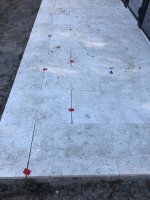I'm wondering what are acceptable margins of error in travertine paver installation around a pool.
For example, how much height difference from one tile edge to the next is acceptable so I cannot ask him to reset that tile? What kind of paver defects are big enough that I can ask him to scrap that tile as breakage and not use it (we are installing one new section today an the pieces he brought look like the breakage from another job imo)? Is it normal for tons of corners to break? How big should the gap be between the travertine and the raised spa tiled wall? What if area that is supposed to be graded is instead level? How much variation can he ignore in the joint line width?
I want to be reasonable in my punch list requests and be able to counter any claims that something I'm pointing out is within workmanlike standards.
For example, how much height difference from one tile edge to the next is acceptable so I cannot ask him to reset that tile? What kind of paver defects are big enough that I can ask him to scrap that tile as breakage and not use it (we are installing one new section today an the pieces he brought look like the breakage from another job imo)? Is it normal for tons of corners to break? How big should the gap be between the travertine and the raised spa tiled wall? What if area that is supposed to be graded is instead level? How much variation can he ignore in the joint line width?
I want to be reasonable in my punch list requests and be able to counter any claims that something I'm pointing out is within workmanlike standards.











